Diversity And Discrimination Exercises
Question 1. Match the following statements in a way that challenges stereotypes:
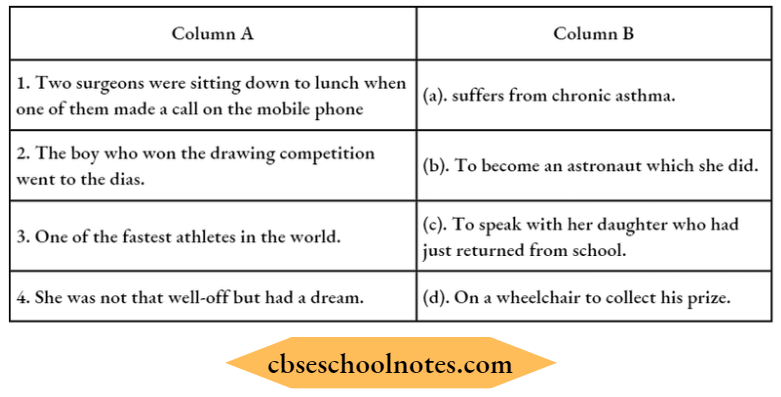
Answer: 1-(c), 2-(d), 3-(a), 4-(b)
Question 2. How can the stereotype that girls are a burden on their parents affect the life of a daughter? Imagine this situation and list at least five different effects that this stereotype can have on the way daughters get treated in the house.
Answer:
The stereotype that girls are a burden on their parents affects the life of a daughter in the following ways:
- They are not properly cared for.
- They are not given a preference for higher education.
- They are not allowed to attend or join schools.
- They are married early.
- They are not provided nourishing food.
- They are engaged early in household work.
Read and Learn More CBSE Solutions For Class 6 Social Science
Question 3. What does the Constitution say concerning equality? Why do you think it is important for all people to be equal?
Answer:
The constitution says the following about equality.
“EQUALITY of status and of opportunities;
and to promote among them all.”
The state shall not discriminate on the basis of caste, creed religion or sex.
- It is important for all people to be equal so that all people are not discriminated against one another.
- The society should become casteless; there should be no place for inequality.
Question 4. Sometimes people make prejudiced comments in our presence. We are often not in a position to do anything about this because it is difficult to say something right then and. there. Divide the class into groups and each group discuss what they could do in one of the following situations:
- A friend begins to tease a classmate because he is poor.
- You are watching TV with your family and one of them makes a prejudicial comment about a particular religious community.
- Children in your class refuse to share their food with a particular person because they think she is dirty.
- Someone tells you a joke that makes fun of a community because of their accent.
- Some boys make remarks about girls not being able to play games as well as them.
- Discuss in class what the different groups have suggested for the above situations, and also talk about the problems that can come up when raising the issue.
Answer:
- The Classmate is to be advised not to do so.
- I would stop him or her at the first instance.
- They would be asked to see her qualities and not of her dirtiness. She
should be asked to be clean. - Advice.
- They would be asked not to do so. They should be given examples of well-known Olympic medal-winning ladies, such as Geeta Phogat, Sakshi Malik, Sania Mirza, Saina Nehwal, PV Sindhu, Hima Das, and P.T. Usha.
Question 5. Below are some statements on people living in rural and urban areas. Tick mark those that you agree with:
On Rural People
- More than 50% of all Indians live in villages.
- People in villages do not like to use modern technology.
- In peak harvesting and plantation season, families work 12 to 14 hours in the fields.
- Villagers are forced to migrate to cities in search of work.
On Urban People
- Life in the city is easy. People here are spoilt and lazy.
- In cities, families spend very little time with each other.
- People in cities only care about money, not about people.
- Living in a city is expensive. A large part of people’s earnings are spent on rent and transport.
Answer:

Question 6. What are prejudices? What does prejudice mean?
Answer:
Prejudices are the opinions which we make about certain people. Some examples are.
- Village people are dirty, lazy and ignorant.
- City people are cunning and corrupt.
By prejudice, we mean, “to judge others negatively and with inferiority.”
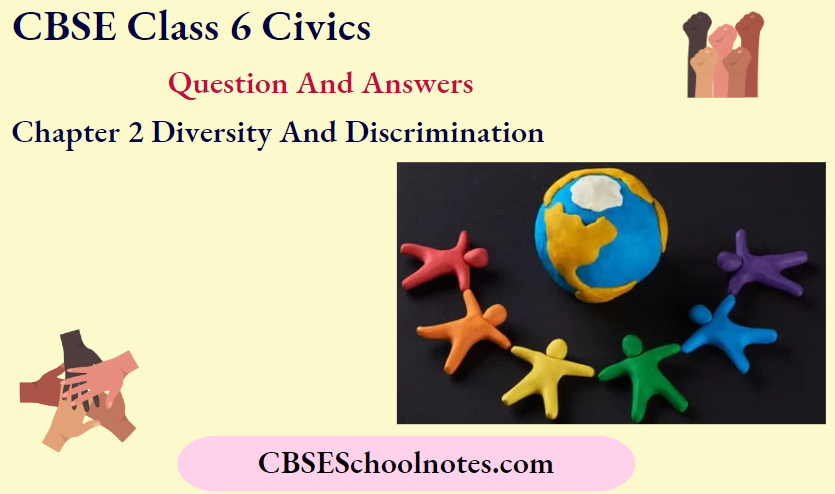
Question 7. Can you list some of the prejudices that you have noticed around you? How do they affect how people treat each other?
Answer:
- Prejudices noticed around us:
- Caste
- Colour
- Eating habits
- Speaking habits.
- They affect how people treat each other.
- They laugh at others
- They tease
- They speak filthy language
- Sometimes they begin to abuse others.
Question 8. Arrange the statements given below in these two sections, according to what you think is appropriate for the section.
- They are well-behaved
- They are soft-spoken and gentle.
- They are physically strong.
- They are naughty.
- They are good at dance and painting.
- They don’t cry.
- They are rowdy.
- They are good at sport.
- They are good at cooking.
- They are emotional.
Answer:
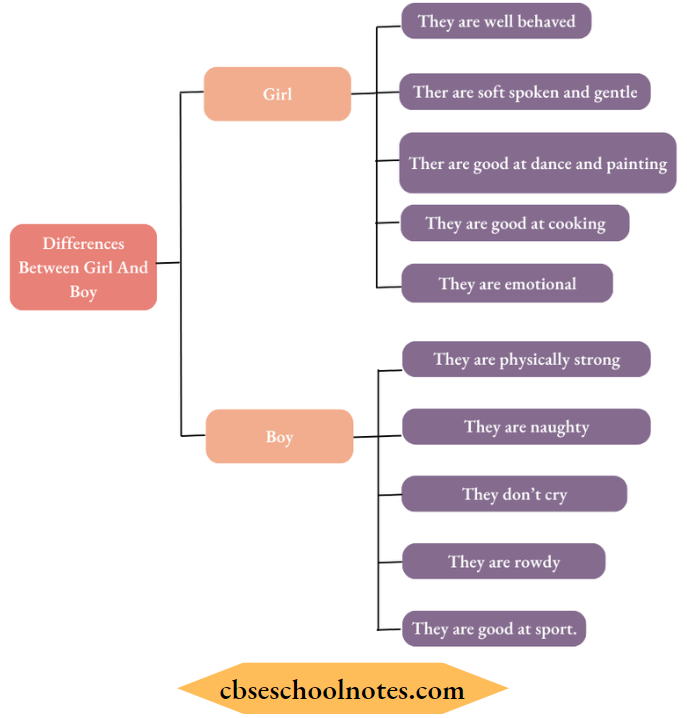
Question 9. The children you see in the illustrations here were seen as ‘disabled’. This term has been changed and now the term used is ‘children with special needs’. Common stereotypes about them are given in large letters. Their own feelings and thoughts too are given.
- Discuss what these children are saying about stereotypes regarding them and why.
- Do you think children with special needs should be a part of regular schools or study in a separate school? Give reasons for your answer.
Answer:
These children are saying that:
- People do not consider them as equal.
- They differentiate them because of their physical disabilities.
Children with special needs should be part of regular schools. This would boost their morale, and they would learn and achieve better. Moreover, it is their right to get the same opportunities.
Question 10. You can take other statements such as they are soft and gentle or they are well-behaved and discuss how these are applied to girls. Do girls possess these qualities at birth or do they learn such behaviour from others? What do you think about girls who are not soft and gentle and those who are naughty?
Answer:
These characteristics are applied to girls because they are born soft, gentle. They are well-behaved.
- The girls possess these qualities by birth most of them. They also learn such behaviour afterwards, remaining in the house or school.
- The girls who are not soft and gentle and who are naughty, acquire these qualities from society. These girls are not considered good girls.
Question 11. Read the story of Bhimrao Ambedkar and answer the following questions:
- Despite the children offering money, the cartmen refused them. Why?
- How did people at the station discriminate against Dr. Ambedkar and his brothers?
- How do you think Dr. Ambedkar felt as a child when he saw the stationmaster’s reaction to his statement that they were Mahars?
- Have you ever experienced prejudice or witnessed an incident of discrimination?
- How did this make you feel?
Answer:
- Despite the children offering money, the cartmen refused because they were Mahars, an untouchable caste.
- People at the station discriminated against Dr Ambedkar and his brothers by refusing them to sit or study near the upper caste people.
- Dr Ambedkar felt very bad when he saw the station master’s reaction to his statement that they were Mahars.
- Yes, we have seen prejudice in our childhood.
- This made us feel unhappy.
- For example: I was poor in my studies; other students teased me for that.
Question 12. In addition to the lower castes being discriminated against, there are also various other communities that are subject to discrimination.
- Can you think of a few other examples of discrimination?
- Discuss the ways in which persons with special needs might be subject to discrimination.
Answer:
- Muslims, tribals, handicapped, disabled persons etc.
- Yes.
1. The other communities being discriminated against are:
- Tribal, physically challenged people.
- Minorities.
2. Other examples of discrimination are: against girl child —girl infanticide.
- Economically weaker sections.
- Special needs people etc.
People with special needs are not given the same opportunities. There are certain prejudices they have to face.
Diversity And Discrimination Very Short Type Questions And Answers
Question 1. What is a stereotype about Muslims? What are its reasons?
Answer:
A common stereotype about Muslims is
They are not interested in the education of girls.
Reasons:
- Poverty
- Mental set-up.
Question 2. What damage is caused by discrimination against Dalits?
Answer:
- Discrimination prevents Dalits from taking certain economic activities.
- It also denies them the respect and dignity given to others.
Question 3. Who fought against the inequalities they experienced in their lives?
Answer: Dr. B.R. Ambedkar.
Question 4. What did the above-mentioned people (Sections of the society) do to end inequality?
Answer:
- Many Dalits fought to gain entry into temples.
- Women demanded the right to education as men did.
- Tribals fought for freedom from moneylenders and for forest rights.
Question 5. Enlist many things that make us what we are.
Answer:
The many things that make us what we are; are:
Our way of life, our family, culture, language, food, clothes and our games.
Question 6. What influences these things?
Answer:
Family background, geography and history influence these things.
Question 7. What makes India diverse?
Answer:
Eight major religions, more than 1600 languages (people’s mother tongue), and more than one hundred dance forms.
Question 8. Whcro do wo fool safe and secure?
Answer:
Wo fool safe and secure:
In the company of people who look like us, who talk like us, who dress like us and who think like us.
Question 9. How do we create stereotypes? When do we create stereotypes?
Answer:
Creation of Stereotypes. Fixing people into an image is called stereotypes.
We create stereotypes when we call people on the basis of their country, religion, sex, race or economic background, stingy, lazy, criminal or dumb.
To give an example; we assume that if a person is Dalit; he/she will be dirty and poor.
Diversity And Discrimination Short Type Questions And Answers
Question 1. What problems are created by the stereotypes?
Answer:
Stereotypes create the following problems:
- They stop us from looking at each person as a unique person.
- They fit a large number of people in one pattern or type.
- They prevent us from doing certain things because of stereotypes.
Question 2. How do we discriminate persons from others?
Answer:
We discriminate persons from others by doing the following activities:
- We do something to put others down.
- We stop them from taking part in certain activities.
- We prevent them from taking up jobs.
- We stop them from living in certain localities or neighbourhoods.
- We prevent them from taking water from the same well or pump.
- We do not allow persons to take tea in the same cup or glass as others.
Question 3. What are the major problems of the poor?
Answer:
Problems of the poor people:

Question 4. What made girl education more, than any other part of the country?
Answer:
- Schools are nearer to residences.
- Good government bus facilities to reach schools.
- 60% of the teachers are women.
- Teachers do not face difficulties in reaching rural schools from far-off places due to good travelling facilities.
Question 5. What are the occupations (works) which are treated well?
Answer:
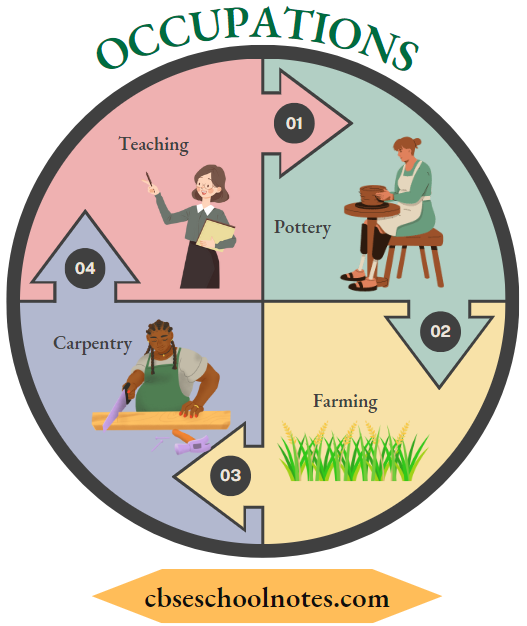
Question 6. Which activities are considered low?
Answer:
Activities considered low are:
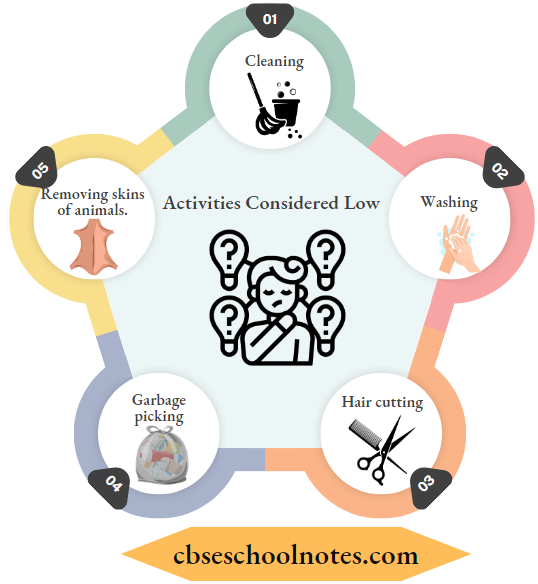
These activities are valued less.
Question 7. What are the plight of the ‘Untouchables’?
Answer:
Untouchables are those people who are engaged in mean work like scavenging. They remove dead animals from the villages.
These untouchables face several plights:
- They were not allowed to enter the homes of upper castes.
- They could not take water from the village well or water pump.
- They could not sit with other higher castes people.
- Their children could not sit with other children of higher castes in a school.
- They were not given the same rights as others.
Question 8. Enumerate the reasons responsible for discrimination.
Answer:
Reasons responsible for discrimination:
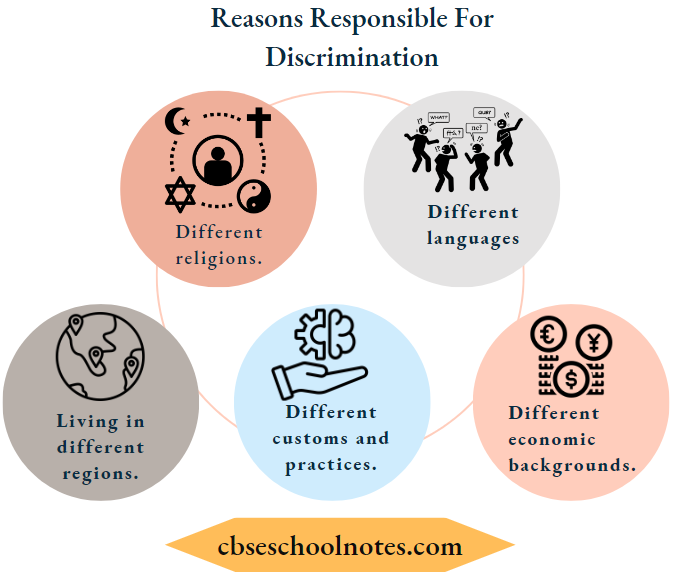
Diversity And Discrimination Long Type Questions and Answers
Question 1. What safeguards have been provided in the Constitution of India against inequality and discrimination?
Answer:
- Everyone has equal rights and opportunities.
- Untouchability is seen as a crime. It has been legally abolished.
- People are free to choose any kind of work.
- Govt, jobs are open to all people.
- Reservations in Govt, jobs for them.
- Specific steps of equality for poor and other marginal communities.
- Respect for diversity ensures equality.
- Freedom to follow any religion
- Freedom to speak their own language
- Freedom to celebrate their festivals
- Freedom to express oneself.
Question 2. Enlist things which we can be prejudiced about.
Answer:
- People’s religious beliefs.
- Colour of people’s skin.
- The region they come from.
- Accent they speak.
- Clothes they wear.
Diversity And Discrimination Multiple Choice Questions And Answers
Question 1. L What does this mean, Judge other people negatively or see them as inferior?
- Prejudice
- Judice
- Post judice
- None of these
Answer: 1. Prejudice
Question 2. On what basis can we prejudice the people?
- People’s religious beliefs
- The colour of people’s skin
- The region they come from
- All of these
Answer: 4. All of these
Question 3. What term do we use for disabled people?
- Challenged person
- Ordinary
- Genius
- None of these
Answer: 1. Challenged person
Question 4. What happens when people act on their prejudice or stereotypes?
- Differentiation
- Discrimination
- Both (1) and (2)
- None of these
Answer: 2. Discrimination
Question 5. What is a common stereotype about Muslims?
- That they are not interested in educating girls
- They are interested in educating girls
- They are rich
- None of these
Answer: 1. That they are not interested in educating girls
Question 6. In which state of India there is less distance between home and school?
- Kerala
- Rajasthan
- Mumbai
- All of these
Answer: 1. Kerala
Question 7. What does the Kerala Government do to help the teachers to reach the school?
- Good bus service
- Good trains service
- Good roads but less bus service
- None of these
Answer: 1. Good bus service
Question 8. Name the first leader of India, who shared his first experience of caste-based discrimination.
- Pt. Jawaharlal Nehru
- Rabindranath Tagore
- Dr. Bhim Rao Ambedkar
- None of these
Answer: 3. Dr Bhim Rao Ambedkar
Question 9. For what purpose did Dr Ambedkar go to England?
- To become a lawyer
- To travel
- To become a leader
- None of these
Answer: 1. To become a lawyer
Question 10. What happened to discrimination after the coming of the Constitution into force?
- Discrimination has reduced
- The discrimination intensified
- Both (1) and (2)
- None of these
Answer: 1. The discrimination has reduced.
